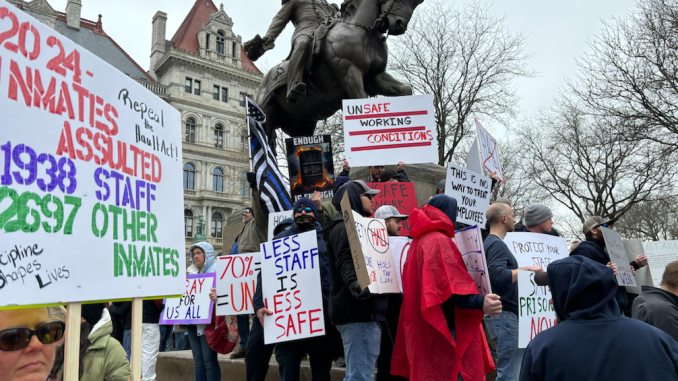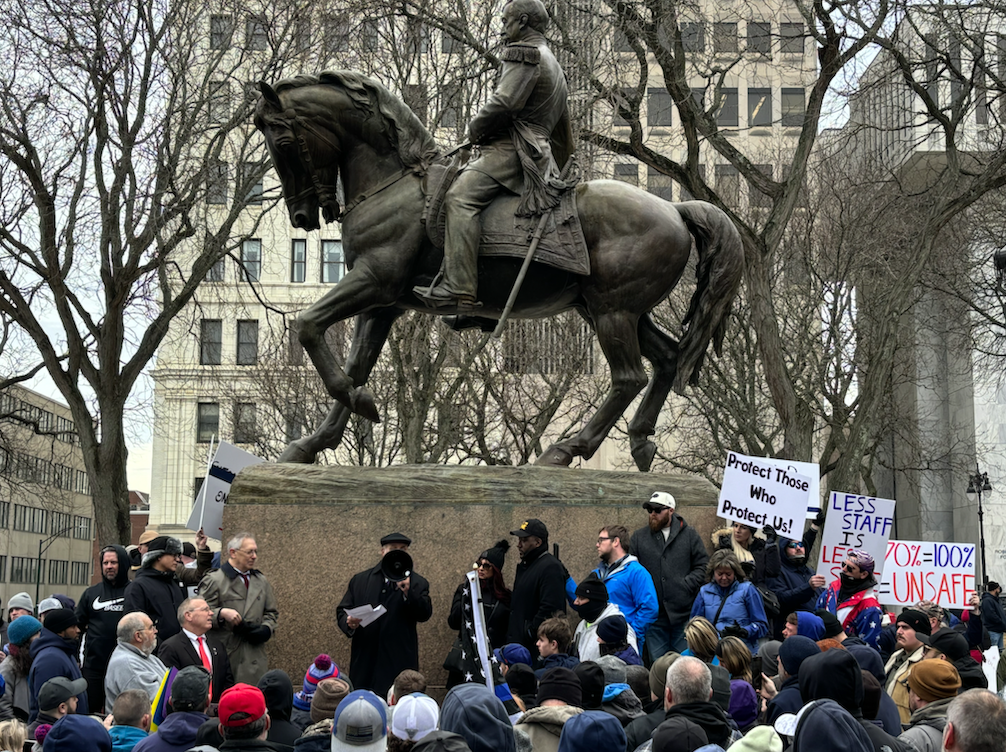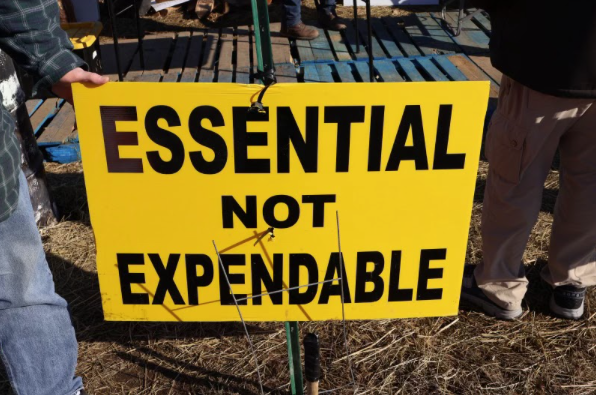
Beginning Feb. 17, approximately 15,000 New York State Corrections Officers went on strike, protesting working conditions in prisons. Approximately 8,000 remain on strike. Identified as a “wildcat” strike, the job action has been considered illegal and is unsanctioned by The New York State Correctional Officers and Police Benevolent Association (NYSCOPBA), the union which represents the workers.
NYSCOPBA union officials said officers refused to enter correctional facilities beginning Feb. 17 due to unsafe working conditions. What began with just three prisons turned into a state-wide strike. Thirty-eight out of 40 facilities in New York had workers refuse to show up for their shifts and strike outside of facilities. As of March 5, 32 facilities remain on strike.
The New York State Public Employees’ Fair Employment Act – known colloquially as Taylor Law – prohibits public employees from striking, requiring public employers to “negotiate and enter into agreements with public employee organizations regarding their employees’ terms and conditions of employment.” Work stoppages, as per this law, are made punishable with payroll deductions, fines and even jail time.
On Feb. 19, Gov. Hochul signed an executive order deploying over 3,700 New York Army National Guard members to provide security in prisons during the strikes. The order also provided means for corrections officers and other staff working to be paid for additional overtime, working to combat the intense staffing shortages and maintain safety in facilities with striking workers.
Despite this, security in facilities remained unstable. Since the beginning of the strike, the Department of Corrections and Community Supervision (DOCCS) has publicly reported that seven incarcerated persons have died.
The main basis for the strike are the extreme working conditions corrections officers assert they are subjected to, including back-to-back 24 hour shifts and consistent understaffing.
Detailed in a memo passed down from DOCCS Commissioner Daniel Martuscello III on Feb. 10, 70% capacity of staff levels in New York State prisons were considered to be 100% staffed.
Workers, advocates and legislators have called for the Humane Alternatives to Long-Term Solitary Confinement (HALT) Act to be repealed through this strike.
The HALT Act was passed in March 2021. It provided harsher restrictions on placing incarcerated persons in solitary confinement as punishment for misbehavior. For the past three years under the HALT Act, NYSCOPBA repeatedly filed complaints about safety in prisons, outlining violent attacks on staff and the unsafe working environment for corrections officers.
“Prior to the HALT Act, incarcerated persons could be segregated from the general population in Special Housing Unit (SHU) cells for up to 23 hours per day over the course of consecutive days, months or even years while being offered as little as one hour of daily ‘out-of-cell recreation,’ which often took place in a caged area attached to the back of their cell,” according to a 2023 DOCCS review of HALT.
It also asserted that “under HALT, ‘segregated confinement’ was newly defined as confinement of a person in any cell for more than 17 hours a day and is generally limited to 15 consecutive days (or 20 days in any 60-day period).”
On May 10, 2021, NYSCOPBA filed a federal civil rights lawsuit against the state of New York and DOCCS. The union complained that without the use of solitary confinement, there was no means of striking fear of punishment into incarcerated persons and thus increased the rate of attacks in prisons.
The lawsuit cited the 14th Amendment of the U.S. Constitution, arguing that it guarantees public employees a workplace that is safe from dangerous conditions. Prison workers have thus taken the stance that HALT harms prison workers and makes their workplace more prone to violence.
Retired corrections officer Nathan Roddy worked at both Wallkill Correctional and Sing Sing Correctional Facilities throughout his career. Due to the repercussions current employees face for striking, Roddy spoke on their behalf, arguing that the strike was not driven solely by HALT, but instead a culmination of factors within the broader system that have built up over the course of 20 years.
In the strike’s efforts to communicate these concerns and their demands for HALT to be rescinded in its entirety, Roddy argued that “the government and Hochul have closed themselves off to any outside influence.” Thus, despite its violation of Taylor Law, workers feel that striking is the only way to make their concerns heard and express these demands.

Assemblyman Brian Maher of New York’s 101st Assembly District is a vocal advocate for the striking corrections officers. Maher joined workers on their picket line and has emerged as an advocate for workers, and in the legislature.
Maher was one of 20 State Assembly Republicans to sign onto a proposal addressed to Hochul, stating that “repealing the HALT Act is an effective and necessary solution to alleviate the immediate situation and provide valuable long-term benefits. The safety of the men and women in these facilities depends on it.”
The proposal detailed how incidents of violence in prisons have increased dramatically since 2021. Incarcerated person on incarcerated person attacks had a 169% increase from 2021-2024, while incarcerated person on staff attacks saw a 76% increase.
Corrections officers have broadly attributed this sharp increase of violent attacks to the HALT Act’s implementation, specifically the limitations it places on officers in their punishment of incarcerated persons. The way HALT was written, Maher argued, “made the atmosphere more dangerous for correction officers, civilian staff and incarcerated individuals.” Under the HALT Act, there were no direct disincentives for aggressive or violent behavior.
The HALT Act’s implementation and the increase in violence within prisons has raised concern and criticism from activists for humane alternatives within facilities.
This argument has also been backed by incarcerated persons’ rights groups who raise concerns over the recent indictment of nine corrections officers in the murder of Robert Brooks.
Brooks was serving a 12-year sentence at the Marcy Correctional Facility for stabbing his girlfriend. He died in custody of corrections officers in December 2024 at the age of 43. Footage from body-worn cameras of officers display the repeated, intense beating of Brooks. He died the next day due to the “compression of the neck and multiple blunt-impact injuries.”
New York State launched a formal investigation into Brooks’ death on Dec. 23, 2024. On Feb. 4, Brooks’ death was ruled a homicide after footage from body cameras worn by the officers showed them punching Brooks while he was handcuffed.
A total of nine individuals were arrested and arraigned – five on 2nd Degree Murder charges, three on 2nd Degree Manslaughter charges and one on charges of tampering with physical evidence.
This has driven some to argue the strikes are meant to cover up officers’ actions and the violence within prisons, particularly cases in which officers are violent toward incarcerated persons.
Increased scrutiny on guards following the murder and indictments has fueled issues within NYSCOPBA. “What’s happening now might seem backwards,” talk show host Brian Lehrer explained. “An incarcerated person dies after being beaten, and it’s the corrections officers who go on strike for not being treated fairly, as they argue it.”
“There was already talk at the State Capitol of changes to the prison system about increased oversight, more independent oversight, as well as talk of closing the Marcy prison,” explained WNYC New York State politics reporter Jimmy Vielkind. “This strike has certainly created a counternarrative that has arguably swallowed up the previous momentum of prison reform in the State Capitol and in the minds of state lawmakers and Governor Hochul.”
Mediations between NYSCOPBA and DOCCS began on Feb. 24. They were mediated by Martin F. Scheinman, a private lawyer who served as the neutral third party within the negotiations.
The list of demands presented by strikers is extensive, with a specific focus on safety and making changes to better protect corrections officers, civilian staff and incarcerated persons within correctional facilities. This ranges from repealing the HALT Act, no more 30% staffing reductions, no discipline/pay reductions for striking workers and consideration of additional recruitment efforts.
On Feb. 28, NYSCOPBA released the agreement that had been reached. The consent award – a binding, court-ordered agreement that, if violated, would result in sanctions for the signing parties – is not subject to a membership vote and is up to individual members to accept.

The union is encouraging workers to return saying they “anticipate that the State will begin to exercise its authority to effect terminations and to continue to serve members with the Temporary Restraining Order (TRO), which will lead to contempt charges, fines and possible jail time.”
Highlights from the agreement include the suspension of HALT-related programming for 90 days from the date of the agreement, continuation of 2.5 overtime compensation for all overtime worked for 30 days from the date of the award and that DOCCS will implement an agreed-upon staffing metric so that when staffing levels go below a certain threshold, HALT-related programming will cease for the day in question.
Maher explained that disapproval of the published negotiations stem from the fact that, while there are parameters to suspend aspects of HALT and respond to workers concerns toward the act, much of the agreement were changes to pay and money, not safety and environment in the facilities. This was disheartening to many workers who had been on strike for over a week, Maher voiced, “because they believe their feelings and their position was not heard and not represented well.”
In a published letter clarifying misinformation surrounding the ongoing strikes, Scheinman asserted that “HALT cannot be repealed in mediation and the Commissioner does not have the legal authority to ignore HALT in its entirety. Frankly, as I understand it, neither does the Governor. I am convinced, the pausing of provisions regarding HALT went as far as the law would allow.”
Mediations between the parties raised concerns considering that both parties already have an established agreement, as workers voted on and passed the contract between NYSCOPBA and the state of New York in 2023, which lasts until 2026. Despite the illegality of the strike and NYSCOPBA not sanctioning its workers’ illegal actions, both parties engaged in negotiations to reach a deal to end the strike.
Scheinman stated in his letter that “representatives from the New York State Correctional Officers and Police Benevolent Association (NYSCOPBA) presented in comprehensive detail the perspectives of the workers, their pain, their concerns and their ideas for resolution. They informed the entire room that the sources of their presentation came directly from the lists, documents and ideas compiled directly from the members on strike.”
Protests have continued early in the third week, with striking corrections officers and opposing incarcerated persons justice activists rallying in Albany outside the state capitol building on March 4.
As well as maintaining the HALT Act, activists are lobbying for the continued protection of prisoners from violence through legislation, claiming suspensions of HALT violate incarcerated persons’ constitutional rights. Corrections officers continue to express discontent with the negotiations that were reached last week, indicating that many plan not to individually accept the deal.
The NAACP New York Conference released a statement on DOCCS’ “decision to ignore the law,” detailing concerns from both sides on the result of mediations between NYSCOPBA and DOCCS, as well as worries over the lasting implications of the many concessions made from the state’s side of negotiations.
“Prolonged solitary confinement is torture and, contrary to the narrative of the moment, it makes everyone in prisons and jails less safe. This law was passed to end the routine inhumane abuses of solitary confinement by DOCCS,” the statement reads.
On March 5, NYSCOPBA released a statement from the Executive Board on the pressing issues with membership and moving forward. “NYSCOPBA remains fully engaged with DOCCS to fight for the demands of our members, despite the formal mediation process having concluded.”
NYSCOPBA advised that it has taken “proactive” steps through both legal and contractual responses to address membership. This includes letters pertaining to a clause from the negotiated contract that states that any employee absent from work without authorization for 10 consecutive workdays shall be deemed to have resigned – as well as health insurance and issues related to pre-approved leave.
Issues with misinformation and communication within the ongoing strike continue, the executive board asserted that “individuals unaffiliated with NYSCOPBA have attempted to negotiate behind the scenes, making requests that are neither legally obtainable nor permissible, ultimately weakening our efforts.”
As many officers continue to ignore the consent award, the outcome of the strike is unclear. The topic has become increasingly polarized as the established consent award continues to be rejected by many officers and lawmakers contributing to the conversation and debate. However, the illegality of the strike and the codification of the HALT Act provide a basis from which an agreement can eventually be reached to end the strike.
“We should all care about humane treatment and humane alternatives to long-term segregating,” Maher expressed. “We also need to be cognizant of humane treatment of corrections officers.”
